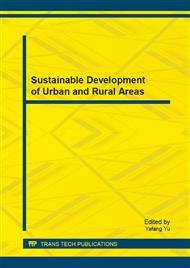p.773
p.777
p.782
p.786
p.790
p.798
p.806
p.810
p.817
Calculation of Water Environmental Capacity of Tidal Reaches in Estuarine Areas on the Basis of Uneven Coefficient
Abstract:
In view of the reciprocating flow of the tidal reaches in estuarine areas and uneven horizontal distribution in the process of pollutants transferring, this thesis proposes a calculation method for the water environmental capacity on the basis of reciprocating flow model and uneven coefficient method. Taking North Channel, downstream of the Min River, as an example, a two-dimensional unstable-state model of water flow-quality is established. According to its hydrologic features and the date measured, flow field and concentration field of this river section are simulated, and meanwhile, response relation curve of the discharge capacity of those general pollutant sources in relation to length of pollution zones, at moments of maximum flood tide and maximum tide ebb, is built. Besides, North Channel is divided into two studied sections whose uneven distribution coefficients at the above mentioned two moments are calculated respectively. Considering the reliability, uneven coefficients at floodtide and tide ebb are replaced by those at the moment of maximum flood tide and maximum tide ebb, and the uneven coefficient method is adopted, on the basis of reciprocating flow model, to calculate the water environmental capacity of North Channel. The findings show that, by adopting the two-dimensional unstable-state model of water flow-quality, values of both the flow field and concentration field in this river section thus calculated, are approximate to the values measured. Chooses 90% confidence surface flow and take neap as sample, the water environmental capacity of CODMn in North Channel is 16716.8t/a.This method, together with the reciprocating flow model and uneven coefficient method, reflects the influence of reciprocating flow and complex pollution migration and diffusion, under the tidal action, on the water environmental capacity of tidal reaches in estuarine areas.
Info:
Periodical:
Pages:
790-797
Citation:
Online since:
January 2014
Price:
Сopyright:
© 2014 Trans Tech Publications Ltd. All Rights Reserved
Share:
Citation:


